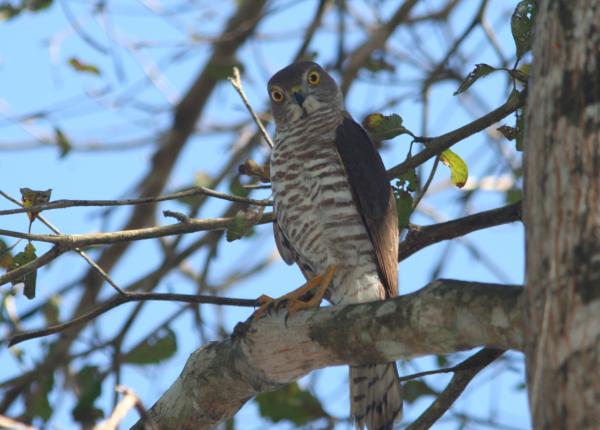Did You Know?
- There are four subspecies of Frances's Sparrowhawk
- A pair of Frances's Sparrowhawks will sometimes cooperatively hunt together to capture prey
- In Comoros, researchers have documented this species nesting in mangroves
How The Peregrine Fund is Helping
Though The Peregrine Fund doesn't work directly with the Frances's Sparrowhawk, we have a very strong conservation program in Madagascar. Apart from the studies we conduct on several endemic raptors, we work hand in hand with the locals to help foster conservation on the island. Among our three conservation areas, we have assisted communities in planting more than 215,000 saplings to restore forests and establish plantations for food and jobs. We have fostered a professional staff of more than 30 Malagasy people, many with advanced degrees, who contribute scientific knowledge and lead their communities in conservation.
Additionally, our efforts in scientific research, habitat conservation, education, and community development help conserve birds of prey around the world. We also supply literature to researchers from our avian research library, which helps scientists around the world gather and share important information on raptor conservation.
Where They Live
This species is found only in Madagascar and the Comoros Islands. Within its range of distribution, it can be found in a variety of different habitats including primary forests as well as degraded second-growth habitats. It also spends its time in urban parks, gardens, and plantations of coconut palms, coffee, cacao, sisal, and fruit trees. It appears to prefer to spend more time near forest edges, rather than deep inside a forest.
Scientists have reported this species inhabiting areas from sea-level to 1600 m.
What They Do
This bird is known for its tameness. It seems to be quite unafraid of people and allows people to get relatively close.
If you ever find yourself in the vicinity of a Frances's Sparrowhawk nest, you will probably figure it out right away. These birds are quite vocal during breeding season. Between the adult pair calling to each other and the food-begging calls of the nestlings, these birds produce quite a cacophony of chirps, whines, and high-pitched calls.
Why They Need Our Help
The Frances's Sparrowhawk is categorized as a species of Least Concern by the IUCN. Though scientists aren't too worried about the future of this species, mainly because it is fairly widespread throughout Madagascar (though it isn't as common on the Comoros) and because it appears to be able to adapt to and survive in degraded habitats. This is all good news for the species. However, this doesn't mean that this small raptor doesn't face any threats. For example, in local villages, this bird is sometimes hunted for food.
What They Eat
The Frances's Sparrowhawk isn't picky when it comes to its diet. It will capture a plethora of different types of animals. While larger insects - such as grasshoppers, dragonflies, and beetles - make up a large portion of this raptor's diet, the list of things it likes to eat doesn't stop there. It will catch spiders, crabs, frogs, lizards, chameleons, snakes, and small mammals, such as rodents and bats. But, there is more! It also is quite adept at catching birds as well. In fact, one researcher spotted a Frances's Sparrowhawk feeding on a Little Grebe.
As you can imagine, catching all these different types of animals takes cunning, speed, and skill - all of which the Frances's Sparrowhawk has! When it is in the mood for a meal, this bird will sit patiently on an exposed perch, keeping its keen eyes out for movement. When it spots something moving below, it will make a mad dash after its prey, which it might grab from the branch of a tree, a tree trunk, or from its leaves. To capture small birds and insects, it will grab them directly out of the air while in flight.
This bird has even been known to stand completely still on riverbanks, patiently watching and waiting. When it spots prey, it will fly down for the attack.
Nests, Eggs, and Young
Frances's Sparrowhawks build their own nests. They will stake out a suitable site, usually high up in the fork of a large tree.
Then they will go about collecting twigs and sticks with which to build their nest. Unlike other raptor species, these birds generally don't use the same nest year after year, but instead build a new one each breeding season.
The female will lay a clutch of 1-5 eggs, but most often somewhere between 2 to 3. These eggs are a bluish white, sometimes speckled with brownish spots. After the female lays the eggs, she and the male will need to incubate them for around one month. During this time, the female does the bulk of the incubation, though the male will relieve her from time to time. After the nestlings hatch, they will grow quickly and are able to fly from the nest for the fist time when they are only around 25 days old!
Frances's Sparrowhawk and the World Center for Birds of Prey
Though the World Center for Birds of Prey is far away from the Frances's Sparrohawk's range, the center still offers fun ways to learn about this raptor, the work we are doing in Madagascar, and other birds of prey. Interactive activities, tours, interesting videos and a children's room with activities from coloring sheets to quizzes to costumes await you. At our visitor center, you can see many hawks up close and learn about the wonderful and interesting adaptations they have in order to survive in their respective habitats.
References:
Global Raptor Information Network. 2021. Species account: Frances's Sparrowhawk Accipiter francesii. Downloaded from http://www.globalraptors.org on 12 Aug. 2021
Kemp, A. C., D. A. Christie, and G. M. Kirwan (2020). Frances's Sparrowhawk (Accipiter francesiae), version 1.0. In Birds of the World (J. del Hoyo, A. Elliott, J. Sargatal, D. A. Christie, and E. de Juana, Editors). Cornell Lab of Ornithology, Ithaca, NY, USA. https://doi.org/10.2173/bow.fragos2.01
Thorstrom, R., and L.-A. René de Roland. 2000. Status and conservation of raptors on the Masoala Peninsula, Madagascar. Pp. 35-41 in R.D. Chancellor and B.-U. Meyburg (eds.), Raptors at risk. World Working Group on Birds of Prey, Berlin and Hancock House, Blaine, WA.









